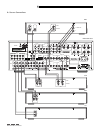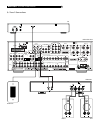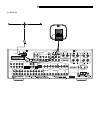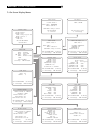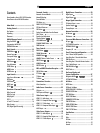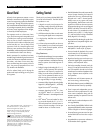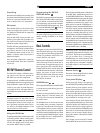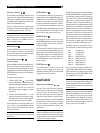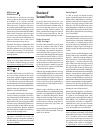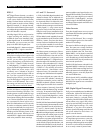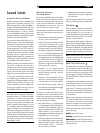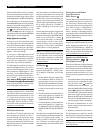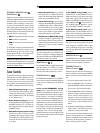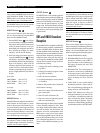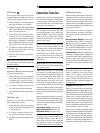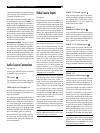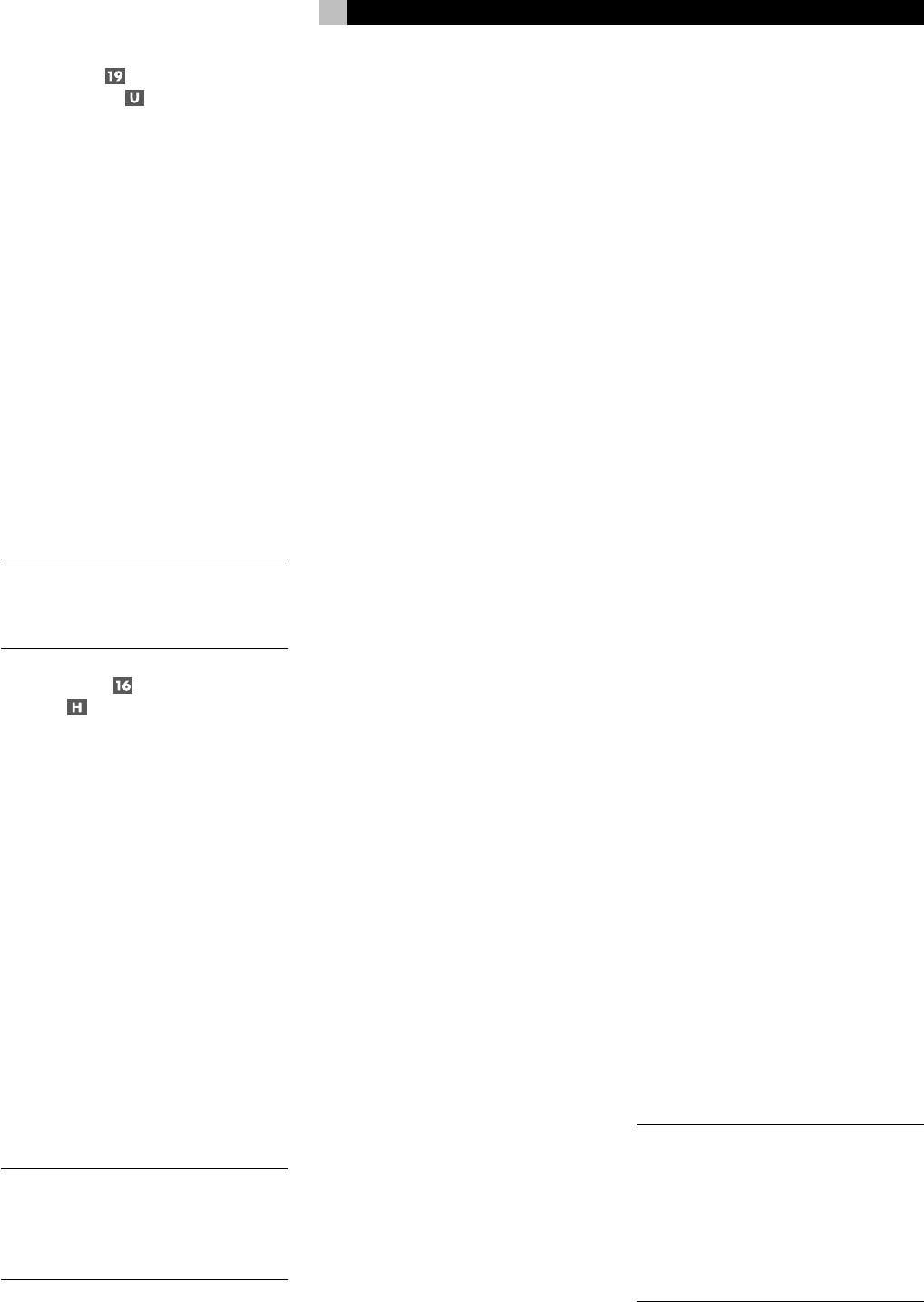
15
REC Button
ZONE Button
The RSX-1055 can record from any analog
source to a VCR or other recorder connected
to the VIDEO 1, 2 or 3 outputs or the TAPE
outputs, even while you are listening to a dif-
ferent input source. To select an input source
for recording, press the REC button on the front-
panel (or the equivalent ZONE button on the
remote). Then, press one of the INPUT SOURCE
buttons within 5 seconds to select the signal
you wish to record. After making your selec-
tion (or if more than five seconds passes), the
input source buttons return to their normal
function, selecting a listening source.
Remember, this selection is independent of the
listening source. While recording, you may
still select a different source (for example, the
built-in tuner) for listening. The record selec-
tion appears in the display to the right of the
listening selection.
NOTE
: The RECORD function requires analog
signals. If you use a digital connection from
a CD player or DVD for listening, you should
also connect an analog signal for recording.
MULTI Input
EXT IN
The MULTI INPUT button (or the EXT IN but-
ton on the remote) overrides all other audio
inputs (both analog and digital) and selects
the audio signal from an external digital adap-
tor. This input only changes the audio signal;
the video signal from the currently selected input
remains in use. When activated, the RSX-1055’s
digital processing is bypassed. An indicator
appears in the front-panel display.
Since the RSX-1055 has built-in decoding for
virtually all analog and digital surround for-
mats, these inputs will not be necessary in most
systems. Typically, you will connect a single
digital cable or left/right analog RCA cables
from each source to the INPUT SOURCE con-
nections and allow the RSX-1055 to decode
the surround information. However, the MULTI
INPUT provides the capability to handle any
future surround encoding format.
NOTE
: When the MULTI input is selected, the
CB output is available only at the CB1
PREOUT connector. No signal is available at
the CB2 PREOUT connector when the MULTI
CH input is selected.
Overview of
Surround Formats
To get the best performance from your
RSX-1055, it helps to understand the many
surround sound formats available today, to
know which decoding process to use for a
particular recording, and how to select it. This
section provides basic background informa-
tion about surround sound formats. The next
sections provide detailed operating instructions.
Dolby Surround
Dolby Pro Logic
The most widely available surround sound
format for consumer audio/video is Dolby
Surround
®
, available on nearly all commer-
cial VHS tapes, many television broadcasts,
and most DVDs. Dolby Surround is the con-
sumer version of the analog Dolby Stereo system
first introduced in the film industry in 1972. It
is a matrix-encoding system that records front
left, front center, front right, and a mono sur-
round channel into a 2-channel stereo record-
ing. During playback, a Dolby Pro Logic
®
de-
coder extracts each channel and distributes
it to the appropriate speakers.
Dolby Pro Logic decoding delivers a mono sig-
nal with reduced high-frequency content to the
surround speakers. The more advanced de-
coder in the RSX-1055, Dolby Pro Logic II, in-
creases the separation and frequency response
of the surround channels for significantly im-
proved performance with Dolby Surround en-
coded recordings.
Dolby Pro Logic II decoding is used for any
analog soundtrack or recording labeled “Dolby
Surround” or any Dolby Digital 2.0 soundtrack.
While it is specifically designed to decode
Dolby Surround recordings, Dolby Pro Logic
can derive surround sound from conventional
2-channel stereo recordings, using phase re-
lationships to extract front, right, center, and
surround channels.
Activate Dolby Pro Logic II decoding with the
Dolby PLII/3ST button described in the next
section of the manual.
Dolby Digital
In 1992, an entirely new digital recording
system, called Dolby Digital, was first used in
the film industry. Dolby Digital is a recording/
playback system that uses compression tech-
niques to store large amounts of audio data
efficiently, much like the JPEG format stores
large photographs in small files on a computer.
Dolby Digital is the standard audio format for
DVDs and for digital television broadcasting
in the United States.
The Dolby Digital system can be used to record
up to six discrete audio channels, but can also
be used for fewer. For example, a Dolby Digital
2.0 recording is a 2-channel stereo record-
ing such as a matrix encoded Dolby Surround
soundtrack. To play this type of recording, use
Dolby Pro Logic II decoding as previously de-
scribed.
The most common use of Dolby Digital, in both
the film industry and in home theater, is Dolby
Digital 5.1. Instead of encoding multiple sur-
round channels on a two-channel recording,
Dolby Digital 5.1 records six discrete chan-
nels: front left, front center, front right, surround
left, surround right, and a Low Frequency Ef-
fects (LFE) channel containing ultra-low bass
signals intended for a subwoofer. A Dolby Digi-
tal decoder extracts the channels from the digital
bitstream, converts them to analog signals and
routes them to the appropriate speakers. All
channels provide full frequency response with
total separation between all channels and large
dynamic range capability. A Dolby Digital 5.1
soundtrack will provide significantly more
impressive surround sound than Dolby Pro Logic
decoding of matrix Dolby Surround.
Decoding of Dolby Digital 5.1 soundtracks is
automatic. When the RSX-1055 detects a Dolby
5.1 signal on one of its digital inputs, it acti-
vates the proper processing. Keep in mind that
Dolby Digital is only available from digital
sources (a DVD, a LaserDisc, or a Digital TV/
Cable/SAT tuner). Also, you must connect the
source with a digital cable (coax or optical)
to an active digital input on the RSX-1055.
NOTE
: Many DVDs have a Dolby Digital 2.0
matrix soundtrack as the default, which should
be decoded with Pro Logic II. The Dolby Digi-
tal 5.1 soundtrack may have to be selected
as an option from the setup menus at the be-
ginning of the DVD. Look for a Dolby Digital
5.1 selection under “Audio” or “Languages”
or “Setup Options” when you insert the disc.
English



